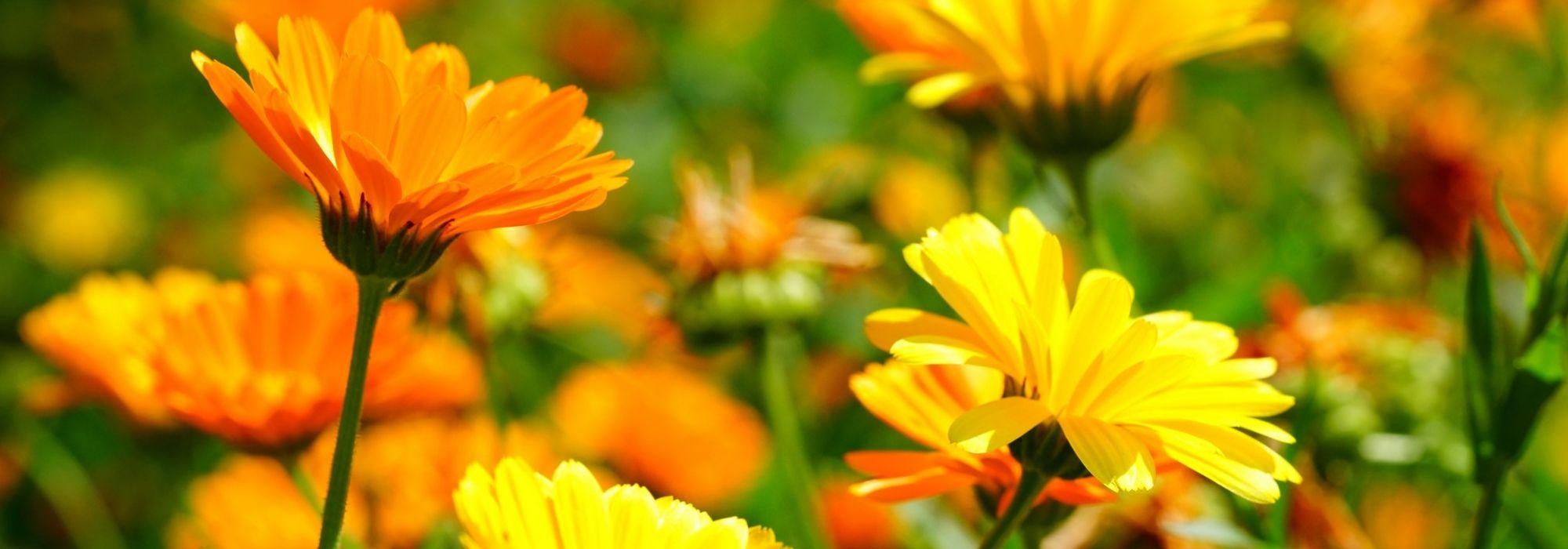
Marigold, Calendula: sowing, planting, cultivation
Contents
Issue in a nutshell
- Pot marigold or Calendula officinalis is a very floriferous annual plant that, from summer through to first frosts, produces a profusion of small daisy-like flowers in cheerful colours: yellow, orange or even pink!
- Pot marigold is an edible flower that can also be grown in vegetable gardens where it helps repel parasitic pests and is used in cooking in salads, herbal teas or infusions
- A staple in homeopathy as an ointment or cream, calendula officinalis is recognised for its soothing properties
- Undemanding and requiring little maintenance, it grows in sun in well-drained soils
- With its rustic charm, it is unrivalled for brightening flower beds, borders, flowering vegetable gardens and planters
A word from our expert
Well known as a culinary plant for its edible flowers enjoyed in herbal teas, infusions or sprinkled in salads and for its calming properties from which cream, ointment, oil or mother tincture — widely used in homeopathy — are extracted, the Marigold or Calendula officinalis is also a pretty, very ornamental annual plant.
If a sovereign remedy for hair and skin, its generous and continuous flowering from May to first frosts also enchants our gardens throughout the season, with minimal maintenance.
An extraordinary generosity and a sunny presence, quite the opposite of meaning attributed to the marigold flower in language of flowers — sorrow or worry…
With its somewhat hardy appearance and its sunny or gentle shades, ranging from golden yellow to bright orange and even pinkish white, the marigold is inseparable from cottage gardens, country gardens and colourful mixed borders in which it self-seeds abundantly and spontaneously.
This daisy-like annual flower is also perfect to bring cheer to a pot on a terrace or balcony and to flowering vegetable gardens where its flowers attract pollinators and repel unwanted insects.
It is one of the easiest annual flowers to grow, sun-loving, it thrives in any well-drained soil.
How to succeed with your marigold sowing in buckets, what is germination time, how to use marigold flowers — we answer all these questions in this fact sheet.
Description and botany
Botanical data
- Latin name Calendula
- Family Asteraceae
- Common name Marigold, Garden marigold, Pot marigold
- Flowering April–May to October
- Height 0.30 to 1 m
- Exposure Sun, partial shade
- Soil type all well-drained
- Hardiness frost tender
Calendula, also called marigold, is an annual plant of family Asteraceae, like daisy, chrysanthemum or Osteospermum, cultivated in European gardens since 12th century. Native to Europe, Mediterranean Basin and south-west Asia. Frost-tender, it is most often grown here as an annual.
Genus comprises about 25 species including Calendula officinalis, also called “garden marigold” or “pot marigold”, staple of our gardens and source of many cultivars with very double and semi-double flowers, in fruity shades and even dwarf varieties. Calendula arvensis, “field marigold” or “common marigold”, is its wild cousin, widespread in countryside.
Marigold forms a bushy tuft, erect, slightly spreading, well ramified and often taller than wide. With fairly rapid growth, Calendula height varies by variety from 0.15 m for dwarf marigolds to 0.70 m for tallest types.
Emerging from basal rosette, brittle stems bear deciduous, lanceolate, oblong leaves with undulate margins. Leaves measure 10–15 cm long and are downy, sometimes sticky. They are bright green to dark green, sometimes tending toward blue‑grey and arranged alternately along stems.
Aromatic, leaves give off strong scent when crushed, reputed to repel many insects such as aphids and whiteflies.
This lush green foliage sets off flamboyant hues and radiate forms of marigold flowers.
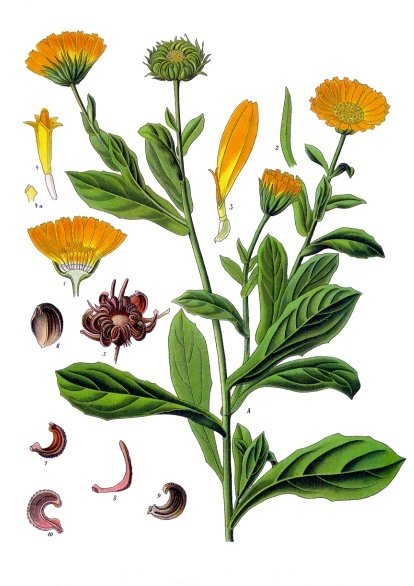
Calendula officinalis – botanical illustration
Calendula’s blooms are radiantly sunny.
From April to September without interruption, Calendula displays a profusion of daisy-like flowers. From start of summer and abundantly until first frosts, leafy upright stems carry terminal inflorescences in solitary heads 5–12 cm diameter. Flowers are single, semi-double and even double, depending on cultivar. While species Calendula officinalis has single row of petals, some cultivars such as ‘Greenheart Orange’ feature very double centre formed of countless ligules making a more or less flattened pompon. ‘Porcupine‘ resembles a small dahlia with ruffled flowers whose tubular petals lengthen progressively toward outer part of corolla: its unkempt headdress calls to mind a porcupine!
Shape of ligules also varies by variety: flat, tubular, dentate at tip or rolled upwards as in Calendula officinalis ‘Sherbet Fizz’.
All garden marigolds bloom around a sun‑yellow, lemon‑yellow tinged with lime or dark brown, almost black centre.
Originally orange‑yellow, Calendula flowers now come in wide range of shades, from fruity to soft and delicate: lemon, grapefruit, bright orange (‘Ball’s Orange’), cream‑white (Calendula officinalis ‘Snow Princess’), to champagne‑rosé.
Flowers are sometimes bicoloured with tips or undersides of petals contrasting, as in Calendula officinalis ‘Sunny Girl’ and ‘Sherbet Fizz’.
While calendula flowers renew continuously offering nearly six months’ flowering, they have habit of closing each evening at dusk, following sun’s course or when it becomes overcast.
This melliferous flowering attracts pollinators often until winter, notably hoverflies that feed on aphids, an indispensable asset in vegetable garden within context of organic cultivation. As bonus, marigold flowers are edible, their flavour recalls saffron and they garnish salads or sorbets. Buds can be pickled in vinegar.
After flowering, inflorescences transform into small incurved spiny fruits resembling nails, containing marigold seeds that disperse easily by wind and will self‑sow fairly readily wherever they like.
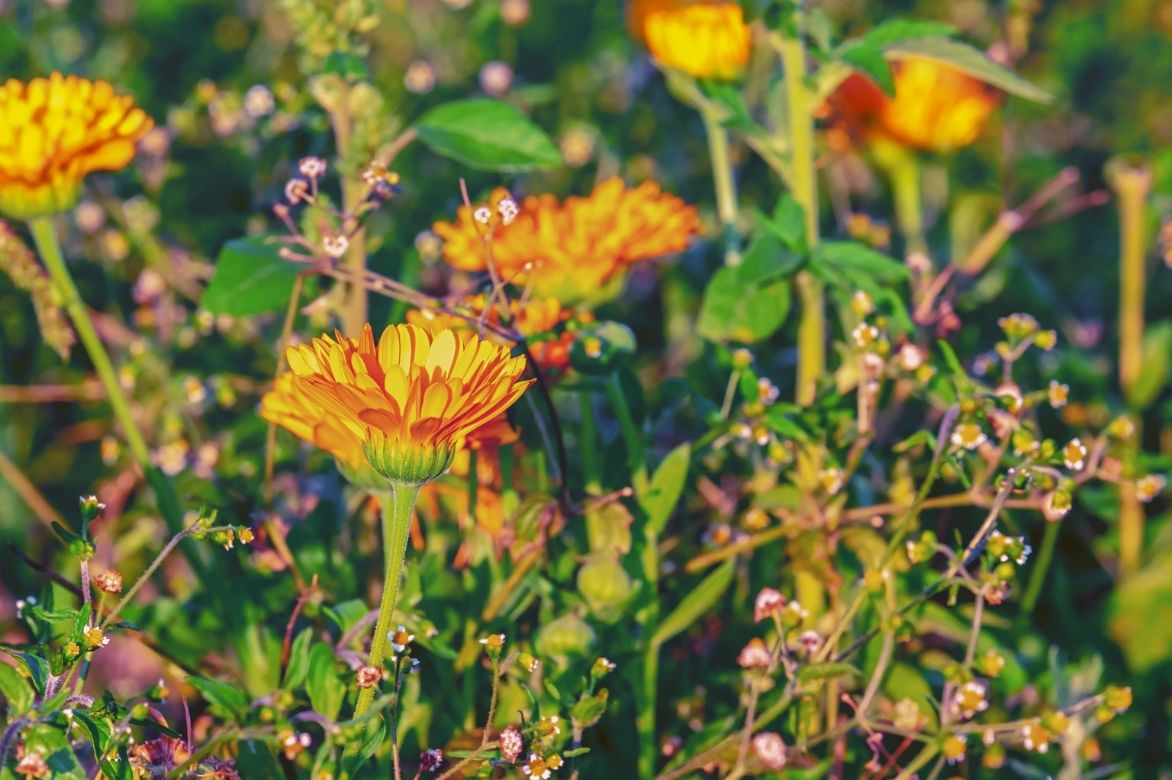
Flowers of marigold
Marigold flowers in warm or subtle colours make excellent long‑lasting cut flowers.
Calendula officinalis or garden marigold is a frost‑sensitive perennial grown in our climate as an annual. Frost‑tender, it dies back during cold season. However it is easy to grow, being indifferent to soil nature. This accommodating annual tolerates all soil types, even slightly calcareous or poor soils. It prefers well‑drained, poor soils and full sun.
With generous, tireless and colourful flowering, Calendula or marigold is inseparable from cottage gardens, naturalistic gardens. It brings vigour and lightness to borders, mixed borders, rockeries and also pots, tubs and window boxes on balconies and terraces. This edible flower also has place in an organic vegetable garden where it attracts aphids while deterring undesired insects from crops.
Long cultivated as medicinal plant, used in cosmetics, pharmacology and homeopathy, Calendula officinalis or pot marigold has many soothing, astringent, depurative, anti‑inflammatory and healing properties. Calendula is used in creams and ointments in cosmetics. Due to its dyeing properties, marigold flowers were once used as food colouring to tint butters and cheeses, hence nickname “false saffron”.
Main species and varieties
Calendula officinalis has given rise to many cultivars with single or double flowers that flower from late spring until first frosts. They come in a wide range of tones from vivid yellow to the most delicate pink and in forms offering dwarf marigold varieties perfect for borders and containers.
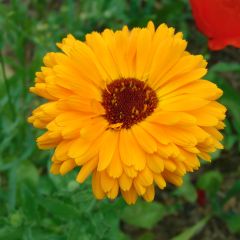
Calendula officinalis Seeds - Pot Marigold
- Flowering time July to October
- Height at maturity 45 cm
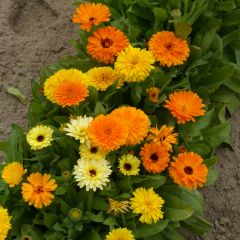
Calendula officinalis Fiesta Gitana Seeds - Dwarf Pot Marigold
- Flowering time July to November
- Height at maturity 30 cm
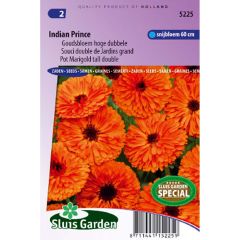
Calendula officinalis Indian Prince Seeds - Pot Marigold
- Flowering time July to October
- Height at maturity 60 cm
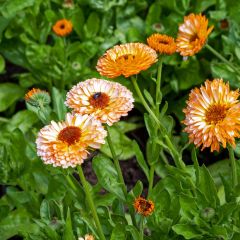
Calendula officinalis Pink Surprise Seeds - Pot Marigold
- Flowering time June to October
- Height at maturity 60 cm
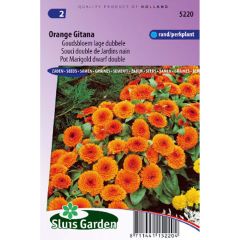
Calendula officinalis Orange Gitana Seeds - Dwarf Pot Marigold
- Flowering time July to November
- Height at maturity 30 cm

Calendula officinalis Fruit Twist Seeds - Dwarf Pot Marigold
- Flowering time June to October
- Height at maturity 15 cm
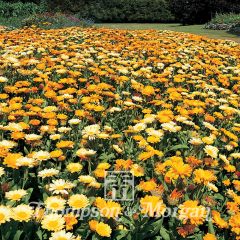
Calendula officinalis Citrus Cocktail Seeds - Dwarf Pot Marigold
- Flowering time June to October
- Height at maturity 20 cm

Calendula officinalis Ball’s Orange Seeds - Pot Marigold
- Flowering time July to October
- Height at maturity 60 cm
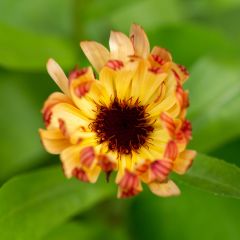
Calendula officinalis Sherbet Fizz Seeds - Pot Marigold
- Flowering time June to October
- Height at maturity 45 cm
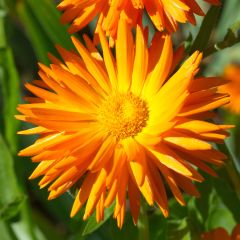
Calendula officinalis Porcupine Seeds - Pot Marigold
- Flowering time June to October
- Height at maturity 45 cm
Discover other Marigold seeds
View all →Available in 1 sizes
Available in 1 sizes

Available in 1 sizes
Available in 1 sizes
Available in 1 sizes

Available in 1 sizes
Available in 1 sizes
Available in 1 sizes
Available in 1 sizes
Available in 1 sizes
Planting
Where to plant garden marigold or Calendula
Calendula is a perennial very sensitive to cold that cannot tolerate frost and is most often grown as an annual in our gardens. It tolerates being grown by the seaside.
Undemanding and very accommodating, garden marigold thrives in any well‑drained soil, even poor and dry, in full sun. Soil that is too fertile would favour foliage at the expense of flowers. It needs full sun to flower well, and a situation sheltered from strong winds that can break its rather fragile stems. It will tolerate partial shade in the warmest regions.
Its simple, colourful flowers are at home in all natural gardens, in a country garden or a wild garden where they quickly create bucolic scenes, in meadow‑style beds, enlivening borders, mixed borders or very sunny rockeries. With its upright habit, marigold brings lightness to summer displays and helps fill gaps in perennial beds or among other annual plants to keep displays in flower until early autumn.
Dwarf varieties are reserved for window boxes and pots on a sunny terrace or balcony.
Marigold is one of the best melliferous plants; it is indispensable in vegetable gardens, because its scent repels nematodes and its flowers attract a constant ballet of pollinating insects, it is a plant that actively contributes to biodiversity. Plant it alongside other edible flowers: marigold produces very pretty cut flowers that will dress up salads!
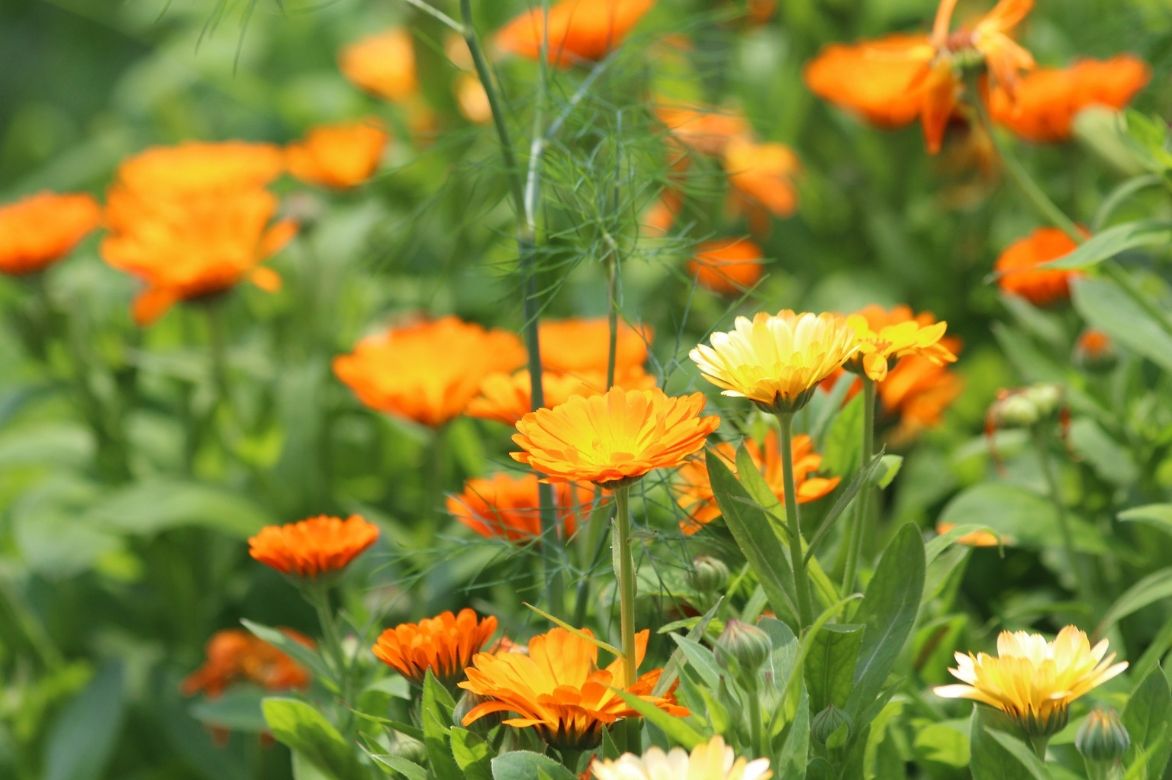
When to plant Calendula or garden marigold?
Planting Calendula or marigold is done in spring in April–May, from March in mild regions, avoiding frost periods.
When and how to sow garden marigold or Calendula?
Direct sowing
Calendula seeds are sown directly outdoors from March until June to stagger flowering, when temperatures approach 20°C. An autumn sowing of marigold in bucket allows earlier flowering: keep your sowings under cover throughout winter and transplant your young plants in spring, after frosts, and consult our advice sheet « How to plant annuals ».
Marigold likes light soils: improve drainage in heavy soils with a little coarse sand. It can be used in large drifts; depending on size, allow 5 to 9 plants per m² for a good effect.
- In well‑tilled soil, sow Calendula seeds thinly by hand. Cover with 1 or 2 cm of compost without burying them deeply
- Water with a fine spray then regularly to keep soil moist during germination, which generally takes 5 to 10 days
- Thin out, keeping only the most vigorous plants every 15 to 20 cm
How to sow seeds directly in the ground?
In pots
Dwarf marigolds are well suited to growing in pots or window boxes: you can mix 2 or 3 varieties, taking their eventual growth into account.
- Lay a good draining layer at the bottom of the container
- Sow a few seeds thinly in a mix of compost and river sand
- Water
Watch our video for all our tips to sow annual seeds successfully!
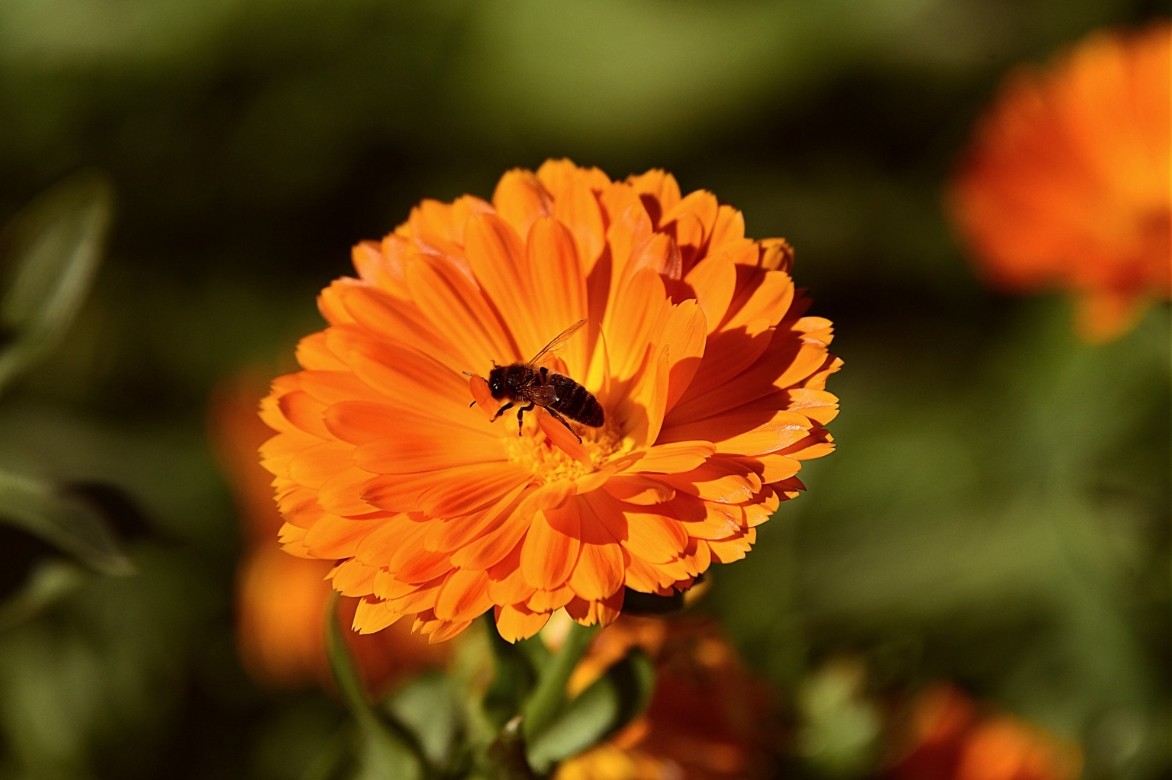
Marigold flowers are melliferous
Care and maintenance of Calendula
Marigold or Calendula is ideal for low-maintenance gardens! Very drought-tolerant, it requires little watering: water only during very hot weather.
Water more regularly but sparingly, allowing the soil to dry out between waterings, as potted marigolds dry out more quickly.
Remove faded flowers to encourage new flowers and extend flowering period.
At the start of winter, when foliage is withered, scorched by first frosts, pull up the clumps of this frost-tender flower. By letting seeds form, you give your marigolds the chance to self-seed!
Potential diseases and pests
At end of summer, your young marigold plants can be susceptible to powdery mildew, which appears as a white coating on the foliage. As a preventive measure: water at the base without wetting leaves and spray decoctions of horsetail, nettle manure or Bordeaux mixture. And follow our advice in our dedicated factsheet on powdery mildew!
If aphids infest them: simply spray with water mixed with black soap. That said, it is a trap crop, very useful in the vegetable garden for deterring unwanted pests!
Propagation of calendula
Calendula or marigold self-seeds readily in the garden if you allow flowers to set seed. Spring sowing of marigolds makes it easy to renew your young plants from one year to the next. Find all steps to make your sowing a success in our “When and how to sow Calendula seeds” section.
Companion planting with calendula in the garden
With its sunlit flowers, the Marigold is unrivalled for creating floriferous summer scenes. Its simple, radiant flowering brings colour and lightness to natural gardens and country gardens, and to cottage gardens where it has been grown for centuries, freely reseeding on the breeze.
Its many varieties allow a wide range of flamboyant colour combinations, from bold to soft, perfect for a romantic garden.
In a naturalistic mixed border, marigold flowers will happily mingle with other daisy-flowered annuals such as Anthemis, Osteospermum, bidens or with summer-flowering perennials such as echinaceas, achilleas and salvias.
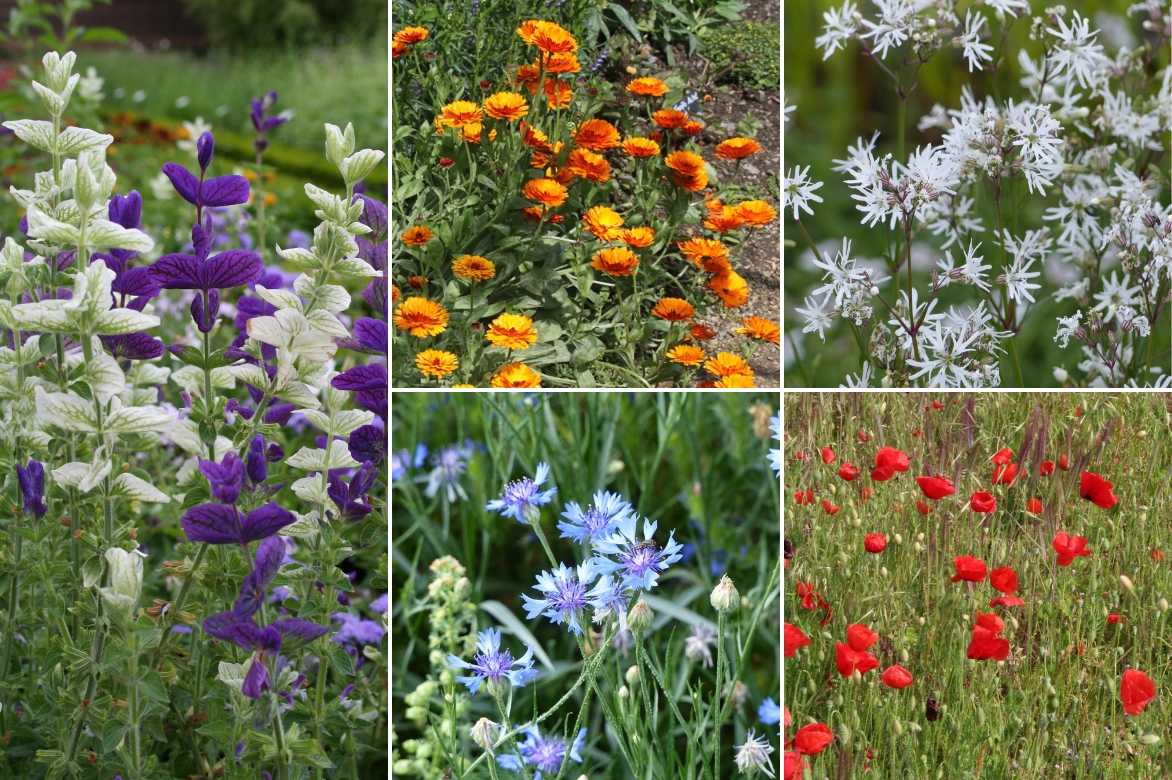
A flowery meadow ambience: Salvia horminum, Calendula officinalis, Lychnis flos-cuculi ‘White Robin’, Centaurea cyanus and Papaver rhoeas
Dwarf marigolds form flowering cushions that dress the base of roses, Buddleia or hibiscus.
In a border, paired with Helichrysum petiolare or Stachys, it creates a leafy setting for slightly taller summer plants such as cosmos, verbenas, scabious, hollyhocks, Cannas and daylilies.
In a lush summer scene reminiscent of old-fashioned gardens, Calendula’s flowering accompanies that of cottage garden perennials such as columbines, asters, lupins, Coreopsis, gaillardias or snapdragons.
Calendula brings colour to the garden at a time of year that is rather less floriferous; it brightens compositions abandoned by summer flowering. In a composition with spicy tones, in the spirit of a Catalan bed, it pairs well with late perennials such as Helianthus, Heleniums, rudbeckias, asters and immortelles, which it will accompany through to autumn.
In a sunny rockery, it is the perfect companion for other low-growing plants like lantanas and succulents such as sedums.
Marigold is a staple of flowery vegetable gardens where it is very useful to pair with other edible flowers such as nasturtium, French marigold (Tagetes), Dahlias or Monarda. Planted at the base of strawberries and tomatoes, its scent also repels nematodes and aphids.
In a small border, fire-coloured varieties marry perfectly with red balcony geraniums, gaillardias, diascias, Lobelias, Zinnias, Surfinias, Million Bells petunias or a scented geranium.
In a pot, pair it with tagetes, zinnias, dwarf dahlias.
In a more contemporary composition, lighten its silhouette with graphic, airy grasses such as Pennisetum.
Useful resources
- Make summer easier by creating low-maintenance borders!
- Discover all our annual plug plants
- To complement your pansies, choose from our beautiful collection of daisy-type annuals and annual plants
- Discover our tutorial: How to make calendula cream in 3 easy steps?
- Subscribe!
- Contents
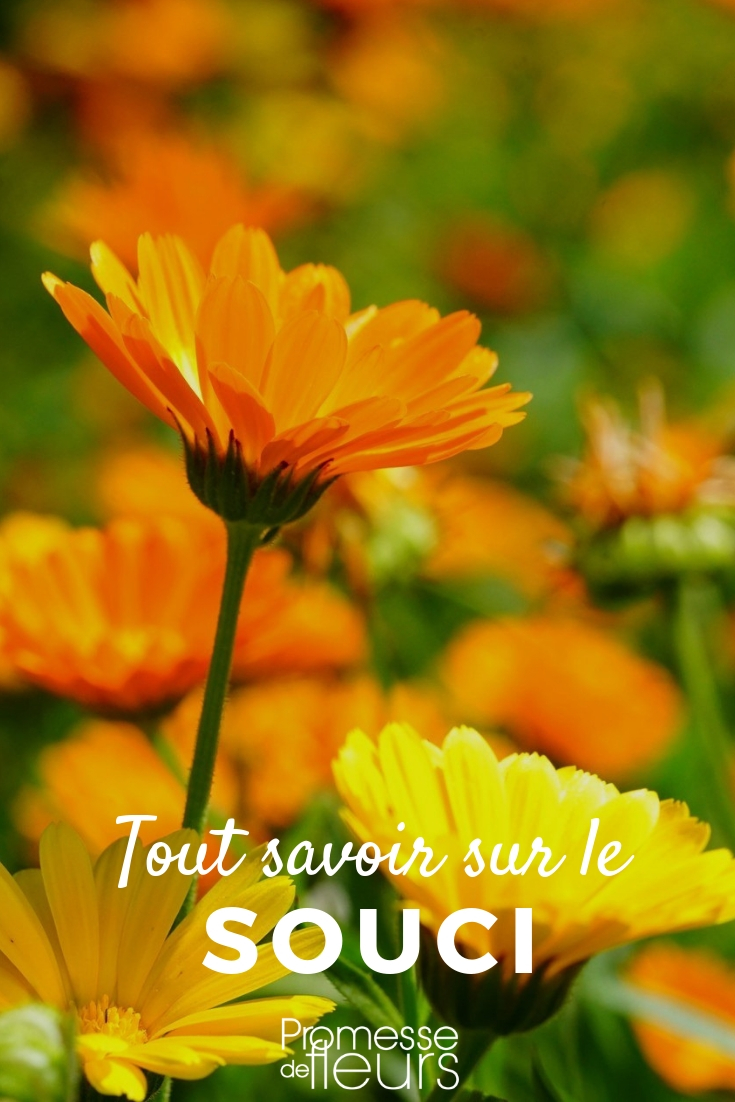































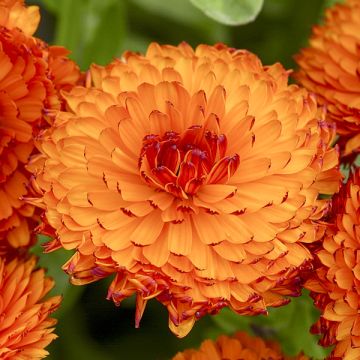
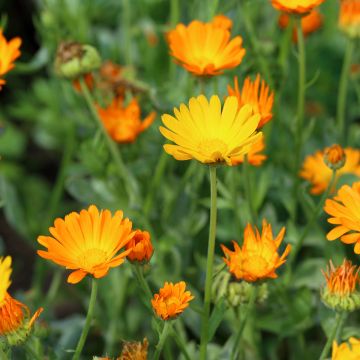


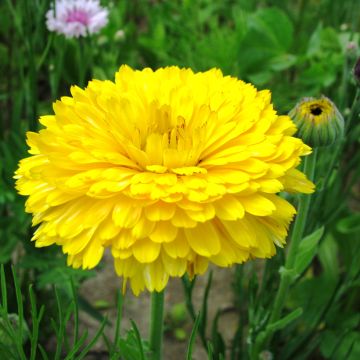
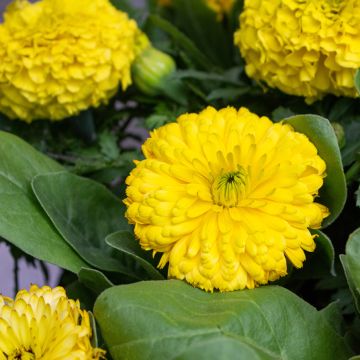
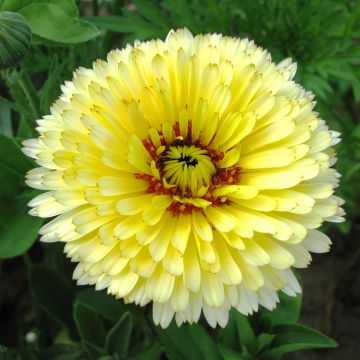

Comments